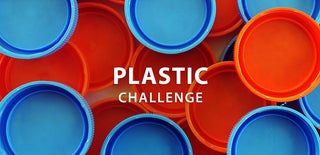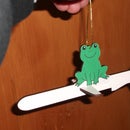Introduction: Vlad the Inhaler
One of the great national heroes of Romania was Vlad III. To misquote Pterry Pratchett, a man who believed in the smack of firm government. Not to mention the hanging, beheading and disembowelment of firm government.
His effective policies garnered him the nicknames "Vlad the Impaler" and "Vlad Dracul". As the latter, he is intimately entwined in the Dracula mythos.
Today, we honour him by making a bust of "Vlad the Inhaler".
Supplies
Used asthma inhaler.
Scraps to decorate.
Step 1: Making the Inhaler Safe
This step requires care and attention. If you are not confident then please don't do it.
The cylinder which contains and meters the drug is pressurised. We don't want to leave a drug-containing pressure vessel in a picture-frame, so we need to ensure that both propellant and drug are removed.
I waited until a windy day and then took the out-of-date puffer outside and activated it downwind. The container claimed 200 metered doses, but after having used this inhaler for a year, I got over two hundred activations before it stopped. by this time the canister was very cold, so I warmed it in my pocket for a few minutes before squeezing a few more shots.
Once the container was as empty as it could be got, I took it into the workshop to cut a hole in the pressure vessel.
Wear eye protection. Use a magnifying glass so that you can look at the workpiece while keeping your head a long way away.
I held the cylinder firmly using a bench-hook and then cut across the neck using a hacksaw. Once the cut was established, I threaded a rag through the saw frame and cut slowly. As soon as I heard a hiss, I stopped and waited for the pressure to dissipate.
Once that had happened, I resumed cutting to make a clear slot of about a centimetre (half an inch) as shown in the last photograph.
We've dispensed the drug and the propellant has now been released, so the cylinder is now empty and safe to use.
Step 2: Making Body and Fixing Head
We're going for a head-and-shoulders bust, so I took a wooden disk from the scrap bin and then sawed three chords off the front to give a base. I marked two points in the base of the plastic inhaler and drilled them out. Then I marked through the inside of the inhaler into the wood, drilled pilot holes and then used a couple of small pan-head screws to fix the inhaler to the wood.
Step 3: Dressing Body
I could find three roughly contemporary portraits of Vlad and all showed him with a jacket worn underneath a shoulder cape in a different colour. (I had temporarily fixed the eyes to the head by this stage.)
I had some scraps of a red/brown very fine leather and some green faux-suede, so I wrapped some printer paper around the form and cut that until I had the right shape for the jacket and cape, and then cut those shapes from the leather and suede.
Rather than sewing a hem onto the faux-suede, I just ran a candle-flame along the edge, which sealed it and prevented any fraying.
The leather was glued to the wood and then the suede glued over the top of that.
A couple of gold sequins stand in for the big brass buttons on Vlad's jacket, and again they are just glued.
Step 4: Decorating the Head
This was without question the most infuriating part of the project. On the other hand, it did remind me that this project involves plastic and could therefore be entered into the competition.
To get a sense of how the face should look, I used tiny snippets of double-sided tape and drops of cyanoacrylate glue (super-glue). Both of those methods held the pieces in place well enough to look at, but the tape was visually intrusive and the glue was extremely insecure. The slightest touch would cause the piece to fall off, which was rather problematic.
To affix things to the plastic used in the inhaler, I tried super-glue, hot-melt glue, two-part epoxy and the laughingly named and very expensive "All Plastics" by Uhu. Every single one of these failed to achieve a good bond.
In the end, I was able to get a good bond by using a hot piece of metal to deform the surface, providing a physical protrusion around which the glue could set and hold.
I had googly eyes from a previous project which worked well, and I used one black pipe-cleaner (chenille stem as they are now called), cut into pieces to act as moustache and eyebrows.
For the jeweled hat, I cut a thin strip of leather and glued that onto the top of the inhaler. I drilled a hole right through the plastic at the rear, and threaded a silver pipe-cleaner through that. A twisted loop of the pipe-cleaner formed the front cockade, and a piece of transparent red plastic stood in a jewel. I had also threaded "pearl" plastic beads onto the silver pipe-cleaner.
Step 5: Background Portraits
There's no-one who enjoys portraits of themselves more than your average blood-stained dictator, so let's keep him sweet with little copies of all the portraits I could find.
I printed them onto T-shirt transfers and then ironed that onto some scrap fabric which had quite a coarse weave. This gives a similar effect to an oil-on-canvas.
The canvas of the painting was then mounted onto some cardboard.
I used a Cricut machine to cut out some frames to suit the portraits, and then gilded them. I bought some Ferrero Roche chocolates and used the gold foil from that to act as gold leaf. The cardboard frame was covered in double-sided tape and then the foil was rubbed onto that. If you try this technique, please let me know if you have found a lolly which is wrapped in gold foil and which actually tastes nice. I've not attached the file for the cricut because it's rather dependent on how large you make the portrait, and it's basically one shape, copied smaller for the cutout.
Step 6: Making Box
I'd bought a cheap picture frame to display and then used one of the many free "design a box" websites to get a file for laser-cutting. I had to modify the produced file as I needed a flange around the outside rather than a closing lid, but that was easy enough to do. I also added some small holes in the flange so that the box could be screwed to the frame when all was done.
The box was glued together, and then the inside was painted a flat matte white and the outside was painted a matte black.
The finishing for the box itself was screwing on a couple of hangers and then putting a loop of wire through them with a soldered western union splice for strength.
Attachments

Participated in the
Plastic Challenge














